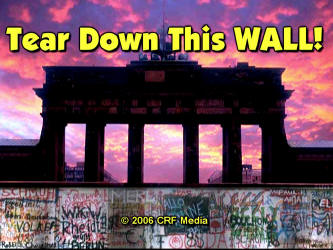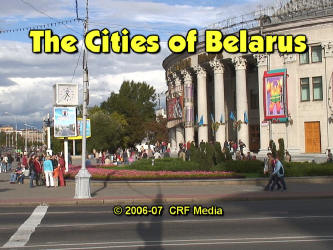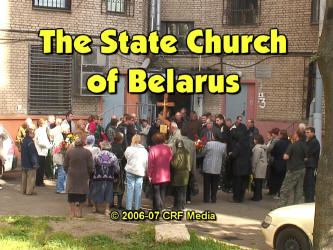|
|
00-19 Belarus 2006 19 Chapters (132:50) Script: Belarus 2006.pdf 03/25/2023
The Belarusians: A People Seeking Hope (25:22)
In the large cities like Minsk, factories are busy and the employees enjoy shopping at the nearby supermarket. Colleges and universities offer hope for the future. The rural areas seem generations apart from the cities. Harvesting potatoes reminds me of my youth growing up on an Arkansas farm in the 1940's. Back then, we rode to town in a horse-drawn wagon. There was no money for a car.
Like America, evangelical churches abound in the cities and, on Sunday, the auditorium is filled with worshippers. The well-directed music is inspiring, often with tunes we could recognize but the words were in Russian. “It Is Well With My Soul” Unlike America, the Communist government has blocked the organization of churches in the rural areas. There were a few clandestine Bible study groups.
For us, Belarus is a country with friendly people, a welcoming atmosphere and surprise discoveries wherever we traveled. It seems God always has amazing “divine coincidences” awaiting us in every country we visit. In Gomel, we were invited to attend and film a wedding. A wedding for Believers is real to them and to the church. Using both High-Definition camcorders, Carl and Don did a splendid job of capturing the lovely ceremony for this Christian couple. Later, after returning to the States, we made a special DVD of the wedding and mailed it to the church. |
 02 A New Day for Belarus: (6:14) It is becoming increasingly difficult to establish new evangelical churches and Bible studies. Gaining government approval for meetings and a meeting place is difficult particularly in the rural areas where there are very few Believers. Evangelical Believers represent less than one percent of the population and are considered a cult by the government and by the Orthodox Church. |
03 MINSK: (4:32) The city of Minsk, with a population of about 2 million is by far the largest city in the country and is an independent administrative unit. This is also a showplace city. The well maintained streets, the new busses, trolleys, and trams as well as the shopping centers and office buildings exude an air of prosperity. |
 04 VITEBSK: (3:43) The drive up Highway M3 from Minsk to the city of Vitebsk is one of the most scenic in Belarus. The rolling, tree-lined hills speak of a time when most of the country was covered with forests. |
 05 MOGILEV: (3:52) Mogilev, with a population of 360,000, is a progressive city with a well-kept park along a small river. The Mogilev Hotel overlooks the park and offers accommodations for tourists as well as business visitors. |
 06 GOMEL: (3:47) In this district, the flat terrain and deep soil allows for growing a variety of crops. These include corn that is chopped and used for cattle forage, vegetables including squash and pumpkins as well as potatoes |
 07 BREST: (3:45) The 200-mile drive on Highway M10 from the city of Gomel to the city of Pinsk in the Brest district passes through an area that was once unproductive swampland, peat bogs, and dense forests. |
 08 GRODNO: (4:22) In Grodno, the growing middle class seems to be real. This is an optimism that extends much deeper than the surface treatment of the apartments buildings of Minsk and other cities. |
 09 TEAR DOWN THIS WALL!: (11:36) For the Orthodox Church, it is only 9 days until Easter. But, in the dark of this night, an unauthorized test on the #4 nuclear reactor at Chernobyl was under way. The crew had disabled emergency backup equipment and turned off warning alarms. This one thousand megawatt nuclear power generator located just south of the Belarus border in Ukraine used highly flammable graphite for the moderator. Then --------------------------------------- |
 10 Rural Belarus: (7:20) Smoke from cooking and heating fires is part of life in rural Belarus. As cold weather approaches, firewood is cut and stacked in preparation for the long winter. Often this involves the entire family as does harvesting hay to feed the cattle, horses, sheep and goats. Just as in the earlier times, gardens are an important part of surviving. They provide food for summer as well as winter and are always carefully . |
 11 Cities of Belarus: (8:26) The cities of Belarus are a place to enjoy, a place for the very young, a place to begin life together, a place to grow old and a place to die. The open-air markets and other shopping areas are where people of all ages can be found. For some, shopping appears to be an effort. For others, it is an opportunity to check out the latest gadgets. But for a child, the real treat is sitting on the back of a pretend horse with his grandmother at his side. |
 12 A Church Planting Movement (15:30) It was in the late 1800’s and the early 1900’s that an evangelical church planting movement was underway in Russia. Missionaries from the Baltic region, Germany, Ukraine and Georgia began the spread of the Gospel of faith and holiness. This message continued an eastward progression all the way to the Pacific Ocean. In less than 60 years, the movement grew from no Baptist Believers to over 600,000. |
 13 The State Religion of Belarus: (6:10) Eleven centuries ago Grand Prince Vladimir of Kiev chose Greek Orthodoxy instead of Roman Catholicism and Islam. Upon his baptism, the Orthodox Church became the State Church of Russia. Today, the Orthodox Church is the dominant religious institution of this country despite the significant decline during the 70 years of Communist rule. Today about 80% of the Belarusians claim the Orthodox faith. |
 14 Impossible to Forget: (5:35) The surprise attack on the Brest Fortress was the beginning of Hitler’s invasion of the Soviet Union. He had over 3 million well-trained and equipped solders positioned along a 1500-mile front that extended from the Baltic in the North to the Black Sea in the South. Hitler planned a quick knockout blow within a matter of weeks. However, these plans did not expect the heroic and sacrificial response presented by the Soviet defenders. |
 15 Just Another Village: (5:43) There are no houses … just chimneys where homes once stood … 23 in all; a stylized representation of wells that once supplied water to the homes … gates connecting to the concrete walkways where roads once were … all a drab gray, the color of ashes from a fire. Nearby, is the representation of the roof of a barn. The sounds of village life are replaced by the solemn peal of bells mounted on the top of each chimney. |
 16 The Killing Fields: (3:11) Further down the road is a different kind of monument that is visited by few and represents a dark time in Belarus; a time that began in 1937 and ended in 1941 when Hitler’s army attacked the Soviet Union. It was during this time, prior to the Great Patriotic War, that Stalin used the Kurapaty Forests as a killing field. During this period, each day the NKVD …. |
|
 18 Faith That Endures: (12:04) The Gospel was brought to Belarus some 200 years ago and by the late 1920’s, many evangelical churches were started, even in the midst of Vladimir Lenin becoming ruler of what became known as the Soviet Union. This was a difficult time for Christians since Lenin proclaimed that there is no God. Religious meetings were banned and the once influential Russian Orthodox Church rapidly decayed. |
|
|
Statement About Video Use U.S. copyright laws protect all media material produced by CRF Media. Posting the videos on alternate web sites is NOT ALLOWED. Fragmentation of the material is STRICTLY FORBIDDEN. THEY ARE NOT TO BE USED IN ANY WAY FOR COMMERCIAL APPLICATIONS. |
|



